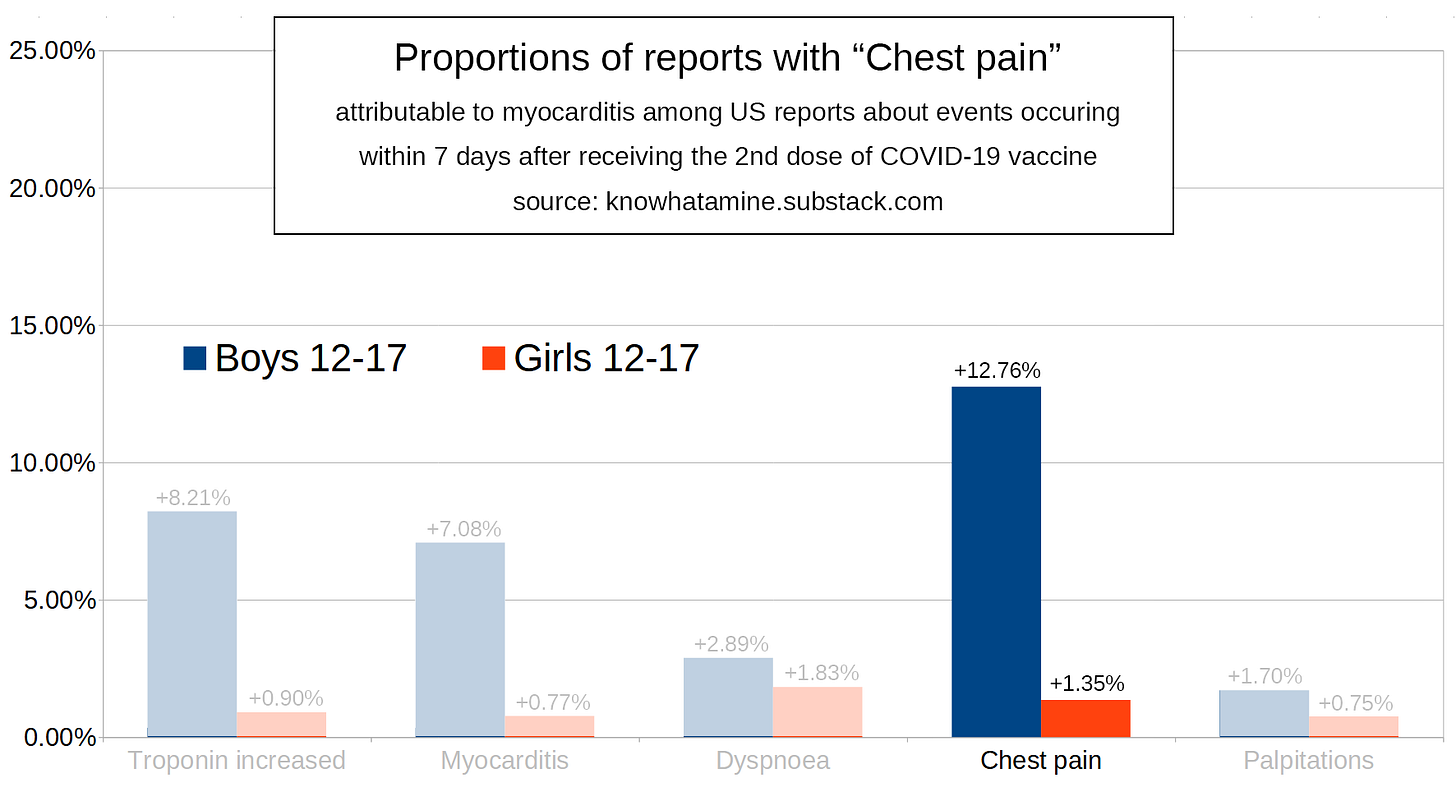Boys 9 times more likely to develop myocarditis?
New estimate: 1,040,029 heart injuries among American children 12-17
Summary
In this article we compare the report proportions of myocarditis-associated terms, particularly the term “Chest pain” between reports about boys aged 12-17 and reports about girls aged 12-17.
This reveals that 12-17 year old boys have a significantly higher susceptibility to myocarditis than girls of the same age in the week after receiving the 2nd dose of their COVID-19 vaccine (p<0.0001, proportion ratio PR=9.3, 99.9% CI:6.0-14.3).
Additionally, I use this opportunity to try yet another method for estimating the absolute number of children who have suffered cardiac damage (935,113 boys and 104,916 girls).
Methods
After determining the proportion of adverse events that mention “Chest pain” among reports about adverse events occuring within 7 days after administration of the 2nd dose, we will try to estimate what proportion of those events can be attributed to myocarditis caused by the COVID-19 vaccine and multiply this difference in report proportions with the absolute number of American children fully vaccinated to gauge the damage that has been done.
We will be looking at the report proportions for terms representing myocarditis-associated symptoms:
among two different VAERS report subsamples:
study group:
Reports about individuals who received 2 doses of a COVID-19 vaccine
reference group:
Reports about individuals who received any vaccine other than those intended to immunize against monkeypox (TYPE=SMALLMNK), smallpox (TYPE=SMALL, known to cause myocarditis) or COVID-19 (TYPE=COVID19)
We will be comparing boys (12-17) to girls (12-17) to gain insights into the sex-differences of myocarditis-associated medical concepts.
All eligible reports either have their age fields populated by the CDC or the age was parsed by running a Regular Expression on the narrative field:
/\W(\d{1,3})\W*ye*a*rs*\W*old$/i
Reports which age is neither specified nor can be parsed were excluded from the search.
Results
Looking at the results of our study report group in Figure 1 we can gather the report proportions containing each of the 5 terms among reports for each of the two age groups.
In Figure 2 we can see the report proportions for the same terms and subsamples in our reference report group. For each concept we now calculate the proportional reporting difference by subtracting the proportions in our reference group from the respective proportions in our study group.
This is expected to eliminate the proportion of events that is falsely attributed to the vaccine.
The result of this process can be seen in Figure 3 from which we can calculate proportional reporting ratios.
The proportion ratios between adults and children are:
9.12:Troponin increased9.19:Myocarditis1.58:Dyspnoea3.86:Chest pain2.27:Palpitations
From this and we can deduce the following assumptions:
“Troponin increased” and “Myocarditis” which are pathognomonic for cardiac injury occur much more frequently in reports about boys than they occur in reports about girls (average PRR: 10.24)
“Dyspnea” or “Palpitations” alone are not an indicator of myocarditis
“Chest pain” indicates myocarditis with moderate specificity, since it is a leading symptom of myocarditis and is generally reported to similar proportion in both boys and girls (Figure 2), but much more frequently among boys in the case of COVID-19 vaccines (Figure 3).
So now we will try to determine what proportion of events mentioning “Chest pain” is attributable to myocarditis by assuming that chest pain occurs and is reported with equal probability in both boys and girls who suffer a cardiac injury.
This involves some simple math. Please refer to my last article for a detailed explanation.
The resulting proportions can be seen in Figure 4.
With these figures we can estimate the number of injured hearts.
Because the USA doesn’t release vaccination figures by gender, we are going to have to approximate gender-specific total vaccinations using the number of filed reports for each group.
There are 4284 reports for boys and 4543 reports for girls about events that occured within a week of the second injection. Since according to the American Academy of Pediatrics 15,100,000 million 12-17 year old children have been vaccinated, we will assume:
Fully vaccinated boys = 15100000 * 4284 / (4284 + 4543) = 7,328,469
Fully vaccinated girls = 15100000 * 4543 / (4284 + 4543) = 7,771,531
We now multiply the number of individuals by the respective difference in proportion.
Boys with heart damage = 7,328,469 * 12.76% = 935,113
Girls with heart damage = 7,771,531 * 1.35% = 104,916
Our estimate of 1,040,029 heart injuries among the 12-17 year old fully vaccinated children is in the range of our previous estimate.
Conclusion
Our estimate of 1 million heart injuries among American children 12 and older remains unchallenged.
Boys (12-17) are more likely to suffer myocarditis (p<0.0001) with a ratio of differences in proportion of 9.3 (99.9% CI:6.0-14.3)
Notes
If you like numbers as much as I do, look at these links to the relevant symptoms on pervaers.com:





